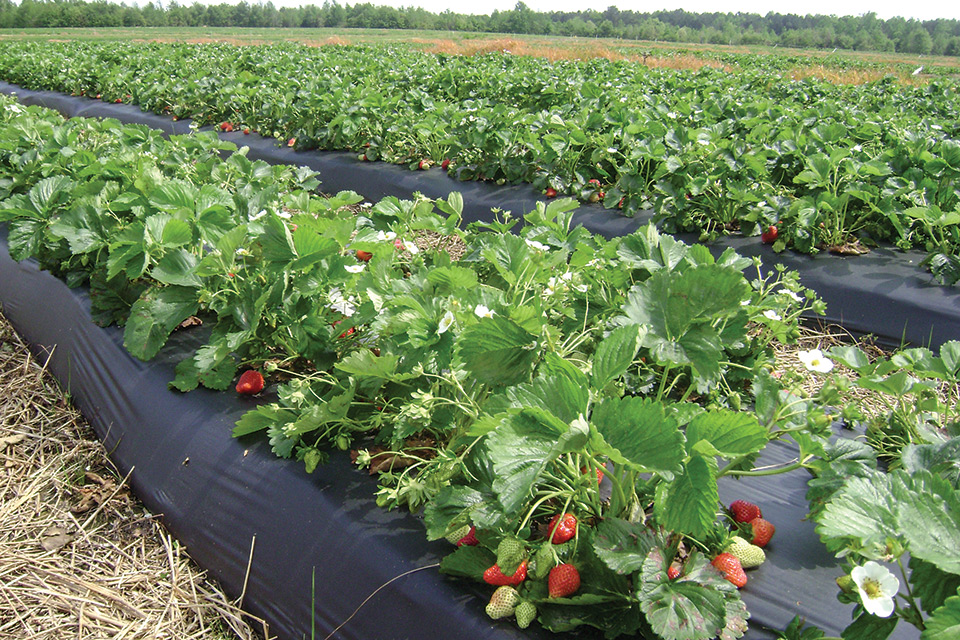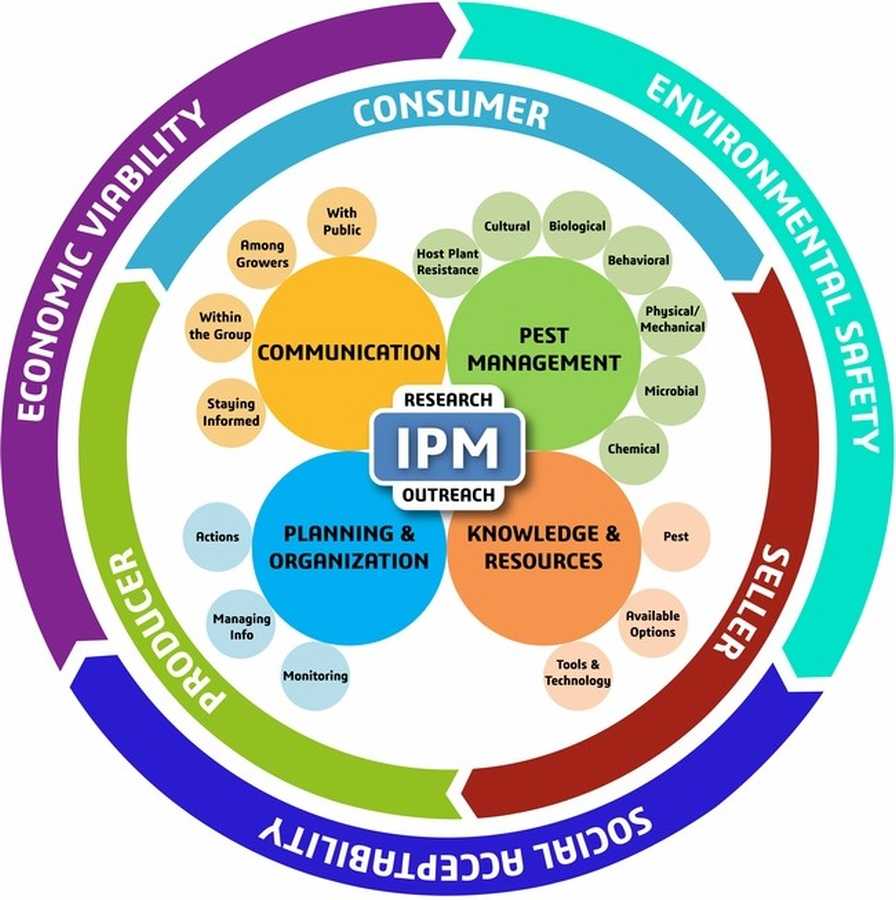Ways to Apply the New IPM Model to Strawberry Production

When used as part of an overall IPM program, biologicals are an effective way to control pests, boost plant health, and increase sustainability.
Strawberry crop demands exacting production methods. So it is a perfect crop to apply the new integrated pest management (IPM) model. This example will help apply this new model to other crops.
Why Have a New IPM Model?
There are several reasons to revisit IPM. We have had significant advances in agricultural technology, modern communication tools, changing consumer trends, increased awareness for sustainably produced food systems, and globalization of trade and travel.
The traditional IPM model primarily focuses on maintaining ecological balance in the cropping system. It also gives some attention to the economics of pest management related to the yield losses.
The new IPM model (which I recently published in the Journal of Integrated Pest Management) is more comprehensive. It covers the management, business, and sustainability aspects of pest management, and discusses various components within. IPM, according to the new model, can be defined as an approach to managing pests in an economically viable, socially acceptable, and environmentally safe manner.
4 Keys to Use the New IPM Model in Strawberry Crops
Let’s take a look at how the new model, with an emphasis on using biologicals, works within strawberry production. I’m basing my advice on information generated by years of studies in California and other reports.
1. Pest Management
(The term “pest” includes arthropod pests, diseases, and weeds. “Management” includes the various practices used to suppress them.)
- Select varieties that produce good yields while resisting biotic and abiotic stresses.
- Good irrigation, choosing the right mulch, and nutrient management contribute to plant growth and health. Micro-sprinklers save water and hold pest management benefits.
- Explore the potential of beneficial microbes and other biostimulants to improve nutrient and water absorption and to maintain crop health.
These biostimulants induce two types of systemic resistance in plants to phytopathogens, arthropod pests, and abiotic stressors (such as salinity and drought).
The first, systemic acquired resistance, helps plants when exposed to chemicals, virulent and avirulent pathogens, and non-pathogenic organisms. These stressors activate certain genes, which produces salicylic acid and pathogenesis-related proteins — these prepare the plants to handle the stress.
For example, if plants are inoculated with non-pathogenic Fusarium spp., something like vaccination in humans and animals, the plant’s defense mechanism turns on, preparing it to fight infection from pathogenic Fusarium spp.
The second, induced systemic resistance, triggers when plants are exposed to beneficial microbes. It activates pathways of two plant hormones, jasmonic acid and ethylene, and also produces pathogenesis-related proteins.
Using beneficial microbes in agriculture is like taking probiotics to improve human health. Inoculate the transplants with biostimulants to induce systemic resistance and periodically apply, especially after fumigation, to improve the beneficial microbial activity in the soil.
Healthy plants resist pest problems and reduce the need for control options. Plant health can be maintained through good cultural practices (biostimulants, nutrients, irrigation, soil conditioning, etc.).
Predatory mites effectively control twospotted and Lewis mites, but relying on natural enemies is not sufficient to control the western tarnished plant bug.
Light traps can be useful for managing lepidopteran pests.
Tractor-mounted vacuums can be a part of the IPM program for managing the western tarnished plant bug. But their pest control efficiency is not necessarily superior to other strategies and are not without some associated risks. For example, operating vacuums requires fossil fuels and they are used at a much higher frequency than pesticide applications.
Use botanical, microbial, and chemical pesticides in combination and rotation. Combinations can improve pest control efficacy and rotations reduce the risk of resistance development.
These biopesticide options can include bacterium, other microbe-based products, and botanicals.
Some of the bacterium options include Bacillus thuringiensis, entomopathogenic fungi, Beauveria bassiana, Metarhizium brunneum, and Isaria fumosorosea.
Botanicals options include azadirachtin, essential oils, and pyrethrins.
As for other microbe-based controls, these include products such as Spinosad. And those from Chromobacterium subtsugae and Burkholderia rinojensis can control one or more kinds of insect and mite pests.
To manage plant diseases, a combination of bacterium, beneficial fungi, and botanicals are a good option. Disease-fighting bacteria include Agrobacterium radiobacter, Bacillus amyloliquefaciens, B. subtilis, Pseudomonas spp., Streptomyces griseoviridis, and S. lydicus. For fungi, consider Coniothyrium minitans, Gliocladium spp., Muscodor albus, Trichoderma spp., and Ulocladium oudemansii. Botanicals such as garlic oil, giant knotweed extract, and neem oil can also be effective.
2. Knowledge and Resources
Understand pest biology, vulnerable stages of the pest, and appropriate strategies for each pest, different life stages, season, and budget.
Accurately identify the issue through visual observation or laboratory diagnosis for proper corrective action.
Try to explore modern technology to monitor crop health.
3. Planning and Organization
Regularly monitor crop health for early detection and prevention of potential pest problems.
Look for signs of pesticide resistance and use appropriate strategies to reduce the risk.
Maintain records of pest occurrence, seasonal trends, strategies that worked, and all the relevant information, to build institutional knowledge for future use.
Take the right action at the right time.
4. Communication
Regularly attend Extension events and read research updates. Choose or design practices that are ideal for your farm based on the research updates.
Periodically provide training to all individuals on the farm who directly or indirectly contribute to good agriculture practices.
Share good management practices with each other for areawide improvement of crop production and pest management.
Try to educate the public so they make better choices when purchasing produce. For example, good IPM practices can be more sustainable than organically approved practices and well-informed consumers can make a choice among conventional, organic, or sustainably produced grains, fruits, and vegetables. Public education also can help to eliminate otherwise good produce that is discarded because of minor imperfections. In strawberry, fruit deformity is caused due to the feeding of the western tarnished plant bug, genetic factors, poor pollination, or very low temperatures. Although most of the deformed strawberries, especially those from insect damage, have equal quality as marketable strawberries, they are discarded because of their shape. If the consumer market can accept deformed strawberries that still have good taste and nutritional quality, it can significantly reduce the waste and the amount of pesticides sprayed to control the western tarnished plant bug.

Other Areas Included in the New IPM Model
Business Aspect. A strong IPM program can help growers produce sustainably while ensuring profitability. Consumer choices depend on their knowledge of sustainable agriculture. When they understand that produce with an IPM or Sustainably Produced label is safe for human and environmental health, it will have a major impact on food production systems.
Sustainability Aspect. The current interpretation or perception of sustainability does not reflect true sustainability in terms of environmental health, profitability, food security, social equality, carbon footprint, and other elements. A good IPM model can address all these issues to ensure farm productivity, food affordability, and environmental safety.
Research and Outreach. Research and outreach are the foundation of IPM to identify pest issues, develop appropriate knowledge for their management, and effectively disseminate the related information. Supporting research and outreach efforts of universities and other entities is essential for continuing IPM.
Regulatory Element. Regulatory guidelines and restrictions for the use of agricultural inputs, certification program, grading of produce, and other such actions will also have a major impact on enforcing sustainability.
Studies Related to the New IPM Model
I’m not recommending this new approach to IPM lightly. Extensive research and studies helped form my recommendations. Here is a list of the studies involved:
• The new integrated pest management paradigm for the modern age. https://doi.org/10.1093/jipm/pmz010
• Biology and management of spider mites in strawberry. In English and Spanish at http://ucanr.edu/spidermiteguide. Information about different species of spider mites and predatory mites is available in this guide.
• Efficacy of botanical, chemical, and microbial pesticides on twospotted spider mite and their impact on predatory mites http://ucanr.edu/blogs/blogcore/postdetail.cfm?postnum=18553
• Entomopathogenic fungi can endophytically colonize strawberry plants when applied to the soil and negatively impact twospotted spider mite infestations http://ucanr.edu/blogs/blogcore/postdetail.cfm?postnum=16821
• How to detect resistance to miticides in twospotted spider mite populations and strategies to reduce the resistance development http://ucanr.edu/blogs/blogcore/postdetail.cfm?postnum=22097
• Comparison between the twospotted spider mite and the Lewis mite http://ucanr.edu/blogs/blogcore/postdetail.cfm?postnum=5771
• An overview of lygus bug biology, damage, and management in strawberries http://cesantabarbara.ucanr.edu/files/75473.pdf
• Lygus biology, monitoring, and management videos http://ucanr.edu/SDYouTube
• Fruit deformity in strawberry from lygus bug and other factors http://ucanr.edu/blogs/blogcore/postdetail.cfm?postnum=19630
• Potential of a solar-powered UV light trap as a pest management option in strawberry http://ucanr.edu/blogs/blogcore/postdetail.cfm?postnum=25307
• IPM tools for controlling western tarnished plant bug in strawberry https://ucanr.edu/blogs/blogcore/postdetail.cfm?postnum=19641
• Entomopathogens (pathogens of insects, mites, and ticks), their modes of infection, and how they can be used as a powerful tool in IPM http://ucanr.edu/blogs/blogcore/postdetail.cfm?postnum=24119
• Biopesticides and IPM https://ucanr.edu/blogs/blogcore/postdetail.cfm?postnum=25912
• Lygus bug and natural enemy populations in organic and conventional strawberries https://ucanr.edu/blogs/blogcore/postdetail.cfm?postnum=14030
• Microbial and bioactive soil amendments for improving strawberry health and yields (2017-2018 study) https://ucanr.edu/blogs/blogcore/postdetail.cfm?postnum=27891
• Beneficial microbe-based products for strawberry health and yield (2016-2017 study)
https://ucanr.edu/blogs/blogcore/postdetail.cfm?postnum=25122
• Beneficial microbes and entomopathogenic fungi for strawberry health and yield (2015-2016 study) https://ucanr.edu/blogs/blogcore/postdetail.cfm?postnum=22709
• Entomopathogenic fungi antagonizing Macrophomina phaseolina https://ucanr.edu/blogs/blogcore/postdetail.cfm?postnum=28274
• Entomopathogenic fungi and other biologicals against Fusarium oxysporum
https://ucanr.edu/blogs/blogcore/postdetail.cfm?postnum=22199
• Micro-sprinklers in strawberry https://ucanr.edu/blogs/blogcore/postdetail.cfm?postnum=19699
• There are several articles in the eJournal of Entomology and Biologicals (https://ucanr.edu/JEB) on crop production and protection topics related to strawberry.
What Does “Biologicals” Mean?
In agriculture, biologicals are any biotic or abiotic inputs of biological origin used for crop production and protection purposes. Biocontrol agents, biopesticides, biostimulants, non-pesticidal beneficial microbes, and soil amendments are included in biologicals.
Biologicals have multiple modes of action and can be used against a variety of pests.
• Biocontrol agents: Predation or parasitization
• Biopesticides: By contact or ingestion through direct action or infection
• Biostimulants: Induced systemic resistance and stimulation of other natural processes
• Non-pesticidal beneficial microbes: Improved nutrient and water absorption
• Soil amendments: Directly or indirectly promote plant growth and health










